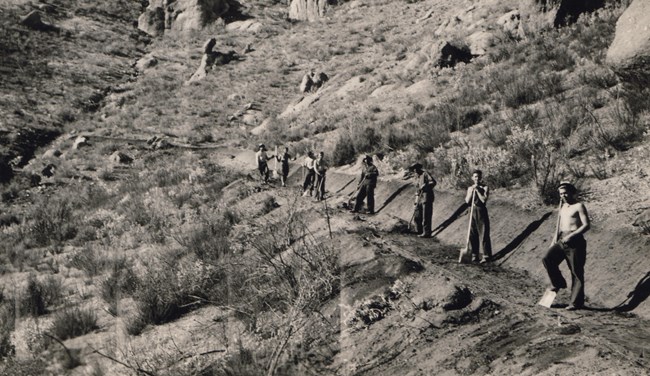
The men who were hired by the CCC were single and between the ages of eighteen and twenty-five. Camps were set up by the U.S. Army, where they worked, which provided them with free room and board. Much of the work was manual labor and the men worked hard for their monthly salary of $30, but $25 was automatically deducted from this pay and sent home to their families. In April 1933, the federal government asked superintendents in national forests and parks to submit work proposals for the CCC. In June of that year, NPS Director Horace Albright commented on the significance of the CCC: "Officials of the National Park Service have a deep appreciation that they were enabled to assist in carrying out President Roosevelt's emergency conservation program, one of the greatest humanitarian movements ever conceived for the relief of distress. In addition to its primary purpose of relief, the conservation work accomplished will be of far-reaching importance to the whole country and will build up the health and morale of a large portion of the young manhood of the Nation, fitting them better to be leaders of the future." Over its 9-year lifespan, the CCC employed about 3 million men nationwide. The CCC made valuable contributions to forest management, flood control, conservation projects, and the development of state and national parks, forests, and historic sites. In return, the men received the benefits of education and training, a small paycheck, and the dignity of honest work. 
The area where the young men lived was called Camp Pinnacles and was located where the NPS maintenance yard and and residential area now exist next to Chalone Creek. The residents had a strict schedule of rising early at 6:30 to a bugle call, alerting them it was time to eat breakfast. They worked from 7:45 to 4 pm then returned to camp for dinner and other evening activities. The meals were reported to be excellent with French toast and bacon for breakfast and roast beef and dougnuts for lunch. Originally the camp was occupied year round, but by 1936 it was deemed too hot to work during the summer so the work crews instead went to General Grant National Park or Sequoia-Kings Canyon as it is known today. They would return to work at Pinnacles again when it became too snowy to work in the Sierras. Nearly 100 years later, people still come to the park to recreate using the trails, roads and buildings constructed by these young men. |
Last updated: May 16, 2018
